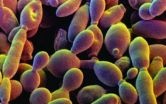Cacao collection expedition may yield weapons for combating witches' broom disease
2011-09-16
(Press-News.org) Fungi found in the leaves and trunks of wild Peruvian cacao trees offer the potential for biological control of cacao diseases such as witches' broom disease, according to U.S. Department of Agriculture (USDA) scientists. Several of the fungal species were previously unknown to science.
Agricultural Research Service (ARS) researchers at the agency's Sustainable Perennial Crops Laboratory (SPCL) and Systematic Mycology and Microbiology Laboratory (SMML) in Beltsville, Md., and Peruvian collaborators conducted cacao collection expeditions in 2008 and 2009 through the Amazon Basin of Peru. The Peruvian Amazon is the heart of the center of diversity for cacao and holds great potential for finding undiscovered cacao and fungal species.
ARS is USDA's principal intramural scientific research agency, and this research supports the USDA priority of promoting international food security.
During the 2008 collection trip to Peru, SPCL research leader Lyndel Meinhardt recorded the incidence of witches' broom disease in wild cacao trees in the upper Amazon region. The disease can cause yield losses of 75 percent in susceptible varieties. A team of scientists, including SPCL geneticist Dapeng Zhang, SMML mycologist Gary Samuels, Meinhardt and others, found that about 14 percent of flower cushions and 13 percent of trunks of wild cacao plants along the rivers were infected with witches' broom disease. This suggests that there is a high level of witches' broom disease resistance in these wild Peruvian cacao populations.
The fungi found in disease-free leaves and trunks of collected cacao tree tissue samples may provide protection against diseases such as witches' broom disease either by stimulating the immune system of the plants or through direct parasitism or antibiotic effects against pathogens. Samuels found several fungal species previously unknown to science in the cacao tissues. The potential for biological control using these fungi is being evaluated by SPCL scientists Bryan Bailey and Ron Collins.
Meinhardt, Zhang and Samuels collaborated with the Instituto de Cultivos Tropicales (ICT), a research center in Tarapoto, San Martin, Peru, to identify new varieties of cacao. The researchers are studying 342 cacao specimens collected from 12 watersheds and are categorizing the DNA of the specimens.
INFORMATION:
Read more about this research in the September 2011 issue of Agricultural Research magazine.
http://www.ars.usda.gov/is/AR/archive/sep11/cacao0911.htm
USDA is an equal opportunity provider, employer and lender. To file a complaint of discrimination, write: USDA, Director, Office of Civil Rights, 1400 Independence Ave., S.W., Washington, D.C. 20250-9410 or call (800) 795-3272 (voice), or (202) 720-6382 (TDD).
END
ELSE PRESS RELEASES FROM THIS DATE:
2011-09-16
SEATTLE, WASH. — September 15, 2011 — The Allen Institute for Brain Science announced today the discovery of a new class of cells in the spinal cord that act like neural stem cells, offering a fresh avenue in the search for therapies to treat spinal cord injury and disease. The published collaborative study, authored by scientists from the University of British Columbia, the Allen Institute for Brain Science and The Montreal Neurological Institute and Hospital at McGill University and titled "Adult Spinal Cord Radial Glia Display a Unique Progenitor Phenotype," appears ...
2011-09-16
A new paper by a team of University of Notre Dame researchers that included Shahriar Mobashery, Jeffrey Peng, Brian Baker and their researchers Oleg Borbulevych, Malika Kumararasiri, Brian Wilson, Leticia Llarrull, Mijoon Lee, Dusan Hesek and Qicun Shi describes a unique process that is central to induction of antibiotic resistance in the problematic bacterium methicillin-resistant Staphylococcus aureus (MRRA).
MRSA first emerged in the United Kingdom in 1961and spread rapidly across the globe. Modern strains of MRSA are broadly resistant to antibiotics of various classes, ...
2011-09-16
Scientists have replaced all of the DNA in the arm of a yeast chromosome with computer-designed, synthetically produced DNA that is structurally distinct from its original DNA to produce a healthy yeast cell. (Yeast chromosomes are often depicted as bow tie-shaped--with each chromosome bearing two "arms" that are positioned similarly to the two sides of a bow tie.)
These results confirm that large pieces of DNA can be synthesized and inserted into a chromosome, and validate the research team's principles for designing synthetic chromosomes. Further, the researchers report ...
2011-09-16
Lyme disease is a dangerous disease which is transmitted by ticks. Blood-sucking ticks ingest the agents that cause the disease – bacteria of the species Borrelia burgdorferi and its relatives – during a blood meal, and subsequently transmit them to the next victim they feast on, often a person. It is estimated that, in Western Europe, up to half of all ticks carry the bacteria. Although the early symptoms of the illness are quite mild, if left untreated, it can result in serious damage to the skin, the joints, the heart and the nervous system, and effective therapy becomes ...
2011-09-16
SANTA CRUZ, CA--Using the Hubble Space Telescope to probe the distant universe, astronomers have found supermassive black holes growing in surprisingly small galaxies. The findings suggest that central black holes formed at an early stage in galaxy evolution.
"It's kind of a chicken or egg problem: Which came first, the supermassive black hole or the massive galaxy? This study shows that even low-mass galaxies have supermassive black holes," said Jonathan Trump, a postdoctoral researcher at the University of California, Santa Cruz. Trump is first author of the study, ...
2011-09-16
Secrets from the age of the dinosaurs are usually revealed by fossilized bones, but a University of Alberta research team has turned up a treasure trove of Cretaceous feathers trapped in tree resin. The resin turned to resilient amber, preserving some 80 million-year-old protofeathers, possibly from non-avian dinosaurs, as well as plumage that is very similar to modern birds, including those that can swim under water.
U of A paleontology graduate student Ryan McKellar discovered a wide range of feathers among the vast amber collections at the Royal Tyrrell Museum in southern ...
2011-09-16
GAINESVILLE, Fla. — Florida has the world's worst invasive amphibian and reptile problem, and a new 20-year study led by a University of Florida researcher verifies the pet trade as the No. 1 cause of the species' introductions.
From 1863 through 2010, 137 non-native amphibian and reptile species were introduced to Florida, with about 25 percent of those traced to one animal importer. The findings appear online today in Zootaxa.
"Most people in Florida don't realize when they see an animal if it's native or non-native and unfortunately, quite a few of them don't belong ...
2011-09-16
While whistleblowers are often respected for their willingness to stand up for what is right and report corporate or workplace corruption, they sometimes face tough consequences for their actions. However, federal legislation like the Dodd-Frank Wall Street Reform and Consumer Protection Act (Dodd-Frank) include provisions to protect whistleblowers from retaliation. Some whistleblower activities are also safeguarded through Securities and Exchange Commission (SEC) and Internal Revenue Service (IRS) federal agency practices.
Under the 2002 Sarbanes Oxley Act (SOX), covered ...
2011-09-16
Washington, DC (September 15, 2011) — Equations that estimate a patient's kidney function work as well as direct, invasive measurements, according to a study appearing in an upcoming issue of the Journal of the American Society Nephrology (JASN). This means that many patients with chronic kidney disease (CKD) do not need to undergo the painful and cumbersome procedures that are performed to monitor kidneys' health.
Measuring CKD patients' kidney function can help physicians anticipate complications and provide optimal treatments. Most measures focus on patients' glomerular ...
2011-09-16
Wouldn't it be nice if all those hours kids spent glued to their PlayStation 3, Xbox 360 or Nintendo DS video games actually resulted in something tangible? Better grades, perhaps? Improved concentration? Superior driving skills?
Over the past decade, many studies and news media reports have suggested that action video games such as Medal of Honor or Unreal Tournament improve a variety of perceptual and cognitive abilities. But in a paper published this week in the journal Frontiers in Psychology, Walter Boot, an assistant professor in Florida State University's Department ...
LAST 30 PRESS RELEASES:
[Press-News.org] Cacao collection expedition may yield weapons for combating witches' broom disease

